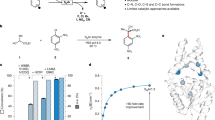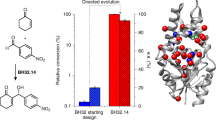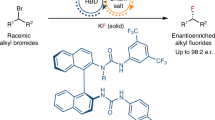Abstract
Bimolecular nucleophilic substitution (SN2) mechanisms occupy a central place in the historical development and teaching of the field of organic chemistry1. Despite the importance of SN2 pathways in synthesis, catalytic control of ionic SN2 pathways is rare and notably uncommon even in biocatalysis2,3, reflecting the fact that any electrostatic interaction between a catalyst and the reacting ion pair necessarily stabilizes its charge and, by extension, reduces polar reactivity. Nucleophilic halogenase enzymes navigate this tradeoff by desolvating and positioning the halide nucleophile precisely on the SN2 trajectory, using geometric preorganization to compensate for the attenuation of nucleophilicity4. Here we show that a small-molecule (646 Da) hydrogen-bond-donor catalyst accelerates the SN2 step of an enantioselective Michaelis–Arbuzov reaction by recapitulating the geometric preorganization principle used by enzymes. Mechanistic and computational investigations show that the hydrogen-bond donor diminishes the reactivity of the chloride nucleophile yet accelerates the rate-determining dealkylation step by reorganizing both the phosphonium cation and the chloride anion into a geometry that is primed to enter the SN2 transition state. This new enantioselective Arbuzov reaction affords highly enantioselective access to an array of H-phosphinates, which are in turn versatile P-stereogenic building blocks amenable to myriad derivatizations. This work constitutes, to our knowledge, the first demonstration of catalytic enantiocontrol of the phosphonium dealkylation step, establishing a new platform for the synthesis of P-stereogenic compounds.
This is a preview of subscription content, access via your institution
Access options
Access Nature and 54 other Nature Portfolio journals
Get Nature+, our best-value online-access subscription
$32.99 / 30 days
cancel any time
Subscribe to this journal
Receive 51 print issues and online access
$199.00 per year
only $3.90 per issue
Buy this article
- Purchase on SpringerLink
- Instant access to full article PDF
Prices may be subject to local taxes which are calculated during checkout





Similar content being viewed by others
Data availability
The data that support the findings in this work are available in the paper and in the Supplementary Information.
References
Anslyn, E. V. & Dougherty, D. A. in Modern Physical Organic Chemistry 637–670 (Univ. Science Books, 2005).
O’Hagan, D. & Schmidberger, J. W. Enzymes that catalyse SN2 reaction mechanisms. Nat. Prod. Rep. 27, 900–918 (2010).
Dewar, M. J. S. New ideas about enzyme reactions. Enzyme 36, 8–20 (2017).
Agarwal, V. et al. Enzymatic halogenation and dehalogenation reactions: pervasive and mechanistically diverse. Chem. Rev. 117, 5619–5674 (2017).
Parker, A. J. Protic-dipolar aprotic solvent effects on rates of bimolecular reactions. Chem. Rev. 69, 1–32 (1969).
Dong, C. et al. Crystal structure and mechanism of a bacterial fluorinating enzyme. Nature 427, 561–565 (2004).
Zhu, X., Robinson, D. A., McEwan, A. R., O’Hagan, D. & Naismith, J. H. Mechanism of enzymatic fluorination in Streptomyces cattleya. J. Am. Chem. Soc. 129, 14597–14604 (2007).
Senn, H. M., O’Hagan, D. & Thiel, W. Insight into enzymatic C−F bond formation from QM and QM/MM calculations. J. Am. Chem. Soc. 127, 13643–13655 (2005).
Warshel, A. et al. Electrostatic basis for enzyme catalysis. Chem. Rev. 106, 3210–3235 (2006).
Bruice, T. C. & Benkovic, S. J. Chemical basis for enzyme catalysis. Biochemistry 39, 6267–6274 (2000).
Uyeda, C. & Jacobsen, E. N. Transition-state charge stabilization through multiple non-covalent interactions in the guanidinium-catalyzed enantioselective Claisen rearrangement. J. Am. Chem. Soc. 133, 5062–5075 (2011).
Lin, S. & Jacobsen, E. N. Thiourea-catalysed ring opening of episulfonium ions with indole derivatives by means of stabilizing non-covalent interactions. Nat. Chem. 4, 817–824 (2012).
Taylor, M. S. & Jacobsen, E. N. Asymmetric catalysis by chiral hydrogen-bond donors. Angew. Chem. Int. Ed. 45, 1520–1543 (2006).
Zhou, H. et al. Organocatalytic stereoselective cyanosilylation of small ketones. Nature 605, 84–89 (2022).
Metrano, A. J. et al. Asymmetric catalysis mediated by synthetic peptides, version 2.0: expansion of scope and mechanisms. Chem. Rev. 120, 11479–11615 (2020).
Taylor, M. S. & Jacobsen, E. N. Highly enantioselective catalytic acyl-Pictet−Spengler reactions. J. Am. Chem. Soc. 126, 10558–10559 (2004).
Taylor, M. S., Tokunaga, N. & Jacobsen, E. N. Enantioselective thiourea-catalyzed acyl-Mannich reactions of isoquinolines. Angew. Chem. Int. Ed. 44, 6700–6704 (2005).
Doyle, A. G. & Jacobsen, E. N. Small-molecule H-bond donors in asymmetric catalysis. Chem. Rev. 107, 5713–5743 (2007).
Brak, K. & Jacobsen, E. N. Asymmetric ion-pairing catalysis. Angew. Chem. Int. Ed. 52, 534–561 (2013).
Zuend, S. J. & Jacobsen, E. N. Mechanism of amido-thiourea catalyzed enantioselective imine hydrocyanation: transition state stabilization via multiple non-covalent interactions. J. Am. Chem. Soc. 131, 15358–15374 (2009).
Pupo, G. et al. Hydrogen bonding phase-transfer catalysis with potassium fluoride: enantioselective synthesis of β-fluoroamines. J. Am. Chem. Soc. 141, 2878–2883 (2019).
Strassfeld, D. A. & Jacobsen, E. N. in Supramolecular Catalysis (eds van Leeuwen, P. W. N. M. & Raynal, M.) 361–385 (Wiley, 2022).
Bhattacharya, A. K. & Thyagarajan, G. Michaelis–Arbuzov rearrangement. Chem. Rev. 81, 415–430 (1981).
Razumov, A. I. Mechanism of the Arbuzov rearrangement. Zh. Obshch. Khim. 29, 1635–1639 (1959).
Razumov, A. I. & Bankovskaya, N. N. Preparation and some properties of intermediate products of the Arbuzov rearrangement. Dokl. Akad. Nauk BSSR 116, 241 (1957).
Appel, R. Tertiary phosphane/tetrachloromethane, a versatile reagent for chlorination, dehydration, and P–N linkage. Angew. Chem. Int. Ed. Engl. 14, 801–811 (1975).
Staudinger, H. & Meyer, J. Über neue organische Phosphorverbindungen III. Phosphinmethylenderivate und Phosphinimine. Helv. Chim. Acta 2, 635–646 (1919).
Niland, C. J., Ruddy, J. J., O’Fearraigh, M. P. & McGarrigle, E. M. Asymmetric organocatalyzed synthesis of α-aminophosphinates via thiourea anion-binding catalysis. Eur. J. Org. Chem. 27, e202301212 (2024).
Lemouzy, S., Giordano, L., Hérault, D. & Buono, G. Introducing chirality at phosphorus atoms: an update on the recent synthetic strategies for the preparation of optically pure P-stereogenic molecules. Eur. J. Org. Chem. 2020, 3351–3366 (2020).
Ye, X., Peng, L., Bao, X., Tan, C.-H. & Wang, H. Recent developments in highly efficient construction of P-stereogenic centers. Green Synth. Catal. 2, 6–18 (2021).
Liu, J., Chen, H., Wang, M., He, W. & Yan, J.-L. Organocatalytic asymmetric synthesis of P-stereogenic molecules. Front. Chem. 11, 1132025 (2023).
Kühl, O. in Phosphorus-31 NMR Spectroscopy: A Concise Introduction for the Synthetic Organic and Organometallic Chemist (ed. Kühl, O.) 7–23 (Springer, 2008).
Neufeld, R. & Stalke, D. Accurate molecular weight determination of small molecules via DOSY-NMR by using external calibration curves with normalized diffusion coefficients. Chem. Sci. 6, 3354–3364 (2015).
Burés, J. A simple graphical method to determine the order in catalyst. Angew. Chem. Int. Ed. 55, 2028–2031 (2016).
Shaik, S. S. in Progress in Physical Organic Chemistry (ed. Taft, R. W.) 197–337 (1985).
Lu, T. & Chen, Q. Independent gradient model based on Hirshfeld partition: A new method for visual study of interactions in chemical systems. J. Comput. Chem. 43, 539–555 (2022).
Nishio, M. The CH/π hydrogen bond in chemistry. Conformation, supramolecules, optical resolution and interactions involving carbohydrates. Phys. Chem. Chem. Phys. 13, 13873–13900 (2011).
Gatineau, D. et al. H-adamantylphosphinates as universal precursors of P-stereogenic compounds. J. Org. Chem. 80, 4132–4141 (2015).
Fu, X. et al. Chiral guanidinium salt catalyzed enantioselective phospha-Mannich reactions. Angew. Chem. Int. Ed. 48, 7387–7390 (2009).
Forbes, K. C. & Jacobsen, E. N. Enantioselective hydrogen-bond-donor catalysis to access diverse stereogenic-at-P(V) compounds. Science 376, 1230–1236 (2022).
Formica, M. et al. Catalytic enantioselective nucleophilic desymmetrization of phosphonate esters. Nat. Chem. 15, 714–721 (2023).
Kolodiazhna, A. O. & Kolodiazhnyi, O. I. Catalytic asymmetric synthesis of C-chiral phosphonates. Symmetry 14, 1758 (2022).
Yamagishi, T. et al. Diastereoselective synthesis of β-substituted α-hydroxyphosphinates through hydrophosphinylation of α-heteroatom-substituted aldehydes. Tetrahedron 59, 767–772 (2003).
Xu, Q., Zhao, C.-Q. & Han, L.-B. Stereospecific nucleophilic substitution of optically pure H-phosphinates: a general way for the preparation of chiral P-stereogenic phosphine oxides. J. Am. Chem. Soc. 130, 12648–12655 (2008).
Han, Z. S. et al. General and stereoselective method for the synthesis of sterically congested and structurally diverse P-stereogenic secondary phosphine oxides. Org. Lett. 19, 1796–1799 (2017).
Gatineau, D., Giordano, L. & Buono, G. Bulky, optically active P-stereogenic phosphine–boranes from pure H-menthylphosphinates. J. Am. Chem. Soc. 133, 10728–10731 (2011).
Xiong, B. et al. Systematic study for the stereochemistry of the Atherton–Todd reaction. Tetrahedron 69, 9373–9380 (2013).
Xiong, B., Shen, R., Goto, M., Yin, S.-F. & Han, L.-B. Highly selective 1,4- and 1,6-addition of P(O)–H compounds to p-quinones: a divergent method for the synthesis of C- and O-phosphoryl hydroquinone derivatives. Chem. Eur. J. 18, 16902–16910 (2012).
Han, L.-B. & Zhao, C.-Q. Stereospecific addition of H−P bond to alkenes: a simple method for the preparation of (RP)-phenylphosphinates. J. Org. Chem. 70, 10121–10123 (2005).
Wang, W.-M. et al. Stereospecific preparations of P-stereogenic phosphonothioates and phosphonoselenoates. J. Org. Chem. 81, 6843–6847 (2016).
Acknowledgements
This work was supported by the National Institutes of Health through grant nos. GM043214 and GM 149244, and F32 postdoctoral fellowship (GM136042) to G.J.L. We thank D. Cui and A. Lowe (Harvard University) for assistance with the NMR experiments, and J. Gair, M. Isomura and S. Nistanaki for their helpful discussions.
Author information
Authors and Affiliations
Contributions
G.J.L. and E.N.J. conceived the work; G.J.L. and M.H.S. designed and conducted the experiments; E.N.J. supervised and directed the research; and all authors wrote the paper.
Corresponding author
Ethics declarations
Competing interests
The authors declare no competing interests.
Peer review
Peer review information
Nature thanks the anonymous reviewers for their contribution to the peer review of this work.
Additional information
Publisher’s note Springer Nature remains neutral with regard to jurisdictional claims in published maps and institutional affiliations.
Extended data figures and tables
Extended Data Fig. 1 Origins of enantioselectivity.
All calculations were performed at the B3LYP-D3/6-311 + + G (d,p)/PCM(toluene)//B3LYP-D3/def2-SVP/PCM(toluene) level of theory at 195.15 K and 1 atm. Most hydrogens are hidden for clarity. (A) Analysis of non-covalent interactions (B) Density-functional-theory-modeled diastereomeric transition states for dealkylation with highlighted differential stabilizing interactions hypothesized to be the origin of enantioinduction.
Supplementary information
Supplementary Information
This file includes Materials and Methods, Supplementary Text, Supplementary Figs. 1–13, Supplementary Tables 1–6 and References.
Rights and permissions
Springer Nature or its licensor (e.g. a society or other partner) holds exclusive rights to this article under a publishing agreement with the author(s) or other rightsholder(s); author self-archiving of the accepted manuscript version of this article is solely governed by the terms of such publishing agreement and applicable law.
About this article
Cite this article
Lovinger, G.J., Sak, M.H. & Jacobsen, E.N. Catalysis of an SN2 pathway by geometric preorganization. Nature 632, 1052–1059 (2024). https://doi.org/10.1038/s41586-024-07811-4
Received:
Accepted:
Published:
Issue date:
DOI: https://doi.org/10.1038/s41586-024-07811-4



